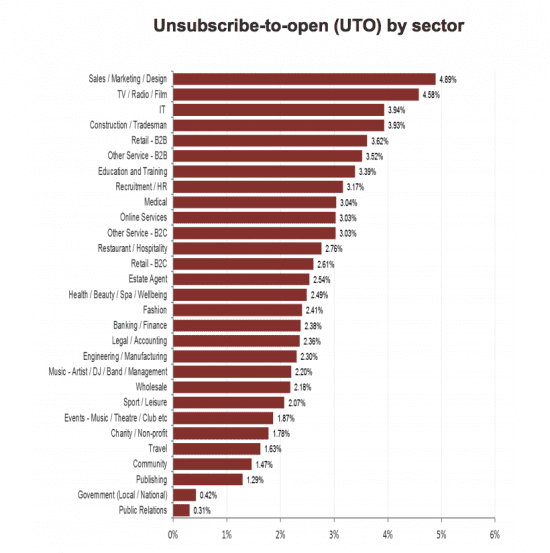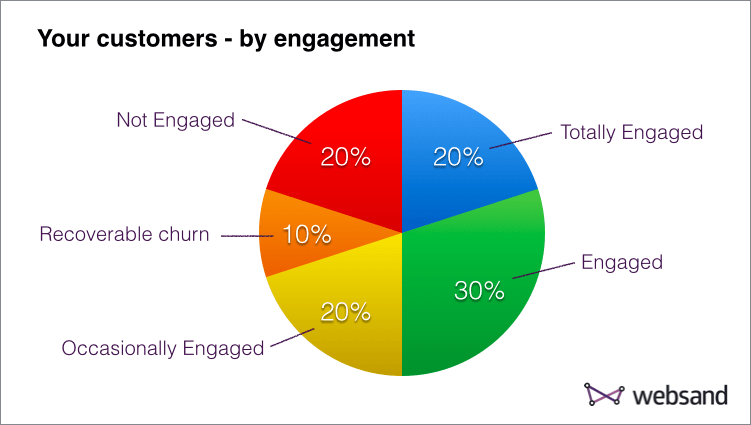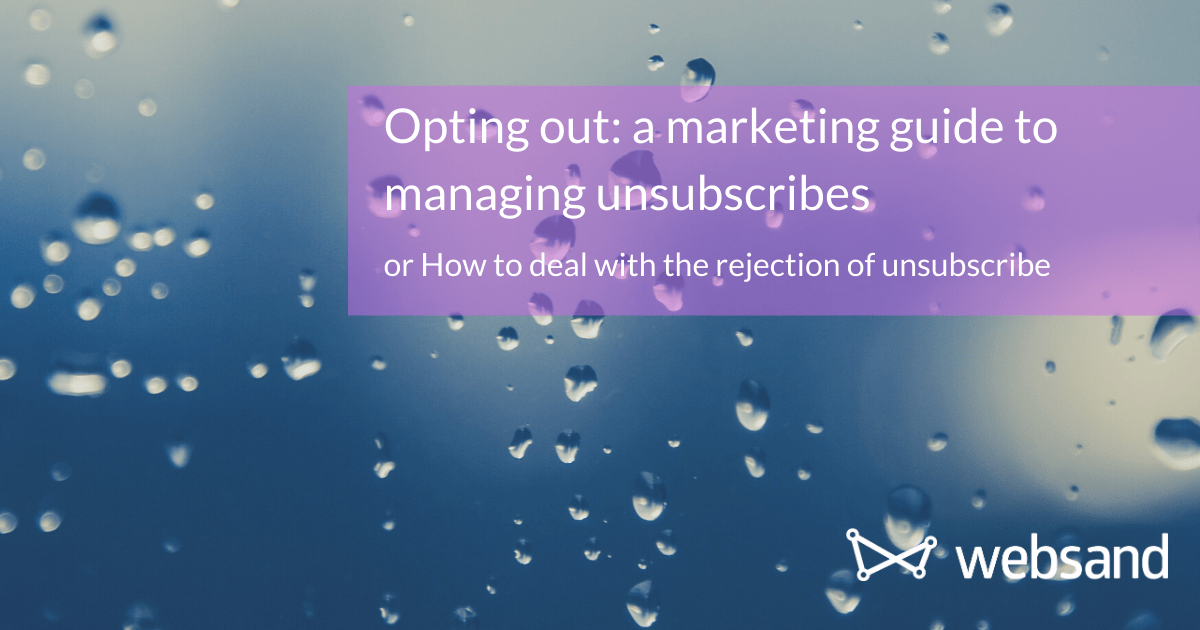Opting out: a marketing guide to managing unsubscribe
In this marketing guide to managing unsubscribes we’ll cover the key things to consider about the opting out side of email marketing. What you need to accept about the dreaded unsubscribe link, and what you should avoid.
The key word is consider. If you are using email marketing you have to include an unsubscribe link, it’s unavoidable. Some of the points within this post may help you to reduce the number of unsubscribes generated from your email marketing.
But this is not a post about shady tactics to remove unsubscribe from your email marketing.
Don’t fear the unsubscribe.
As an email marketer it’s easy to fear the unsubscribe link, especially if the size of your audience is a KPI you are measured against. First thing to say on that is don’t worry, here’s why.
1. You can’t run email marketing without an unsubscribe link. The ICO Direct Marketing Guide states: An organisations identity must not be disguised or concealed in any way and there must be a valid contact address for individuals to opt out or unsubscribe.
2. GDPR. You need to process personal data to send email and legally your audience have the right to remove themselves from that processing (and your email marketing) if they so wish. So they can break-up with your email marketing at anytime.
3. It’s not the number of people that have signed up for your email marketing that’s important. It’s always been the number of customers that actually ‘give a damn’ that count. If you are being measured against the size of your audience as a KPI, then I’d suggest to change that metric to one based on ‘audience engagement’.
Appreciate the complexity of the relationship.
Email marketing should reflect the relationship between the person receiving an email from your business and their history with your business. Be that as a loyal and valued customer, or a prospect signing up.
Unfortunately, one of the downsides of any relationship is the potential for a breakup. Unlike other relationships, in email marketing you have to make breaking up as easy as possible. To make matters worse, you also have to be needy. You need include an unsubscribe link within your email marketing, so in effect you also have to ask ‘are you sure you want to continue with this’.
The relationship between your business and your audience is constantly changing. It’s a complex relationship in that it’s made up of lots of factors that are beyond your control. If someone decides to have an inbox clear out, that could mean an unsubscribe and the end of that chapter of your marketing relationship. If inbox providers add an unsubscribe link at the top of their inbox viewer (yes I’m looking at you Apple!) that could also increase unsubscribes.
So it’s likely that you will receive some unsubscribes every time you send an email marketing campaign.
How many unsubscribes should I expect?
We’ve established (and hopefully agreed) unsubscribes are something you can expect, but how can you tell if your unsubscribe rate is good or bad?
The first suggestion is to review your current level of unsubscribe to previous levels of unsubscribe and set your own benchmark. Industry averages suggest an acceptable level of unsubscribe rates between 0.2% and 0.5% of messages send. However, if you’ve got an unsubscribe rate higher than 0.5% of messages sent, then that suggests you’ve got an issue to resolve.
Looking further afield and checking some published independent evidence, According to Smart Insights (back in 2017) the average open to unsubscribe rate is 2.59%.
That sounds high, but it doesn’t mean a 2.59 unsubscribe rate, it means for every 100 people that open an email marketing message, between 2 and 3 people will unsubscribe.

Don’t manage unsubscribes like this
Firstly, make it as easy as possible. Remember their initial action is to say that they don’t want to receive further email marketing from you. Making it difficult does nothing for your reputation, and people do talk about these things.
So don’t…
Try to hide the unsubscribe link.
Make them log in with a password to unsubscribe, unless you’ve got a fantastic, completely understandable and justifiable reason for them to do so.
Take them on a fantastical journey, e.g. make them click three places or confirm three times that they want to unsubscribe.
And please don’t make them fill out a survey before unsubscribing. You already know they want to leave, surely that should tell you everything you need to know.
What you should do. The marketing guide to managing unsubscribes
Now we’ve established what not to do. What should you do? What is the suggested marketing guide to managing unsubscribes!
It’s a growing trend to asking customers or prospects to select which group they want to unsubscribe from. This works on the assumption that your audience doesn’t really want to leave. They have the “I’d love to receive news on pancakes, but please don’t send me anything about maple syrup” mindset.
Personally, for the reasons listed in the previous section, I accept the unsubscribe process and respect the reason for someone to leave. I understand why this a popular thing to ask, it’s hard to let go, however, if you are communicating in a respectful and relevant way, then it should not be an issue.
But I appreciate that the ‘pancake interest’ mindset does exist. If you believe it really is important to your business (and it might be really important), then ask the people on the way into your business, rather than on the way out.
Another thing you should do is create an unsubscribe confirmation page on your website. It’s a polite way of dealing with the breakup, provides confirmation to the person unsubscribing and gives them a route back in (if they’ve made a terrible mistake).
If you want out, then PLEASE hit unsubscribe.
When a customer unsubscribes, they you are telling you (the marketer) that they aren’t interested anymore. It’s over.
What a gift of clarity, I’d suggest that is something to be embraced.
So your unsubscribe should be a clear, a call to action.
Some people are pushing for unsubscribe to be included in the header of the email. If you think that will work for you, then give it a try.
We make it a key part of our marketing communications and we put it at the footer – not as a call to action, but because that is where people expect to find the unsubscribe within an email.
See this great example of an unsubscribe from ‘The Hustle’ – a daily newsletter.

It’s not you Mr Customer, it’s me!
It’s human nature to try and win the hearts and minds of those people that aren’t interested.
“I can make them change!”, “I can convince them”.
If they have bought from you in the past, and within a specific time frame you have a decent chance of winning them back – see our posts on increasing customer retention for more on that.
However, if they have never bought from you and are apathetic to your marketing messages (never open anything), then perhaps it’s time to accept that they just aren’t into your product or service and break up with them.
Respecting people’s privacy
As an email marketer you have to be dealing with personal data. Fact is you can’t send email marketing without someone’s email address.
Including unsubscribe just used to be regarded as best practice, but now under GDPR it’s a legal requirement.
So it’s more important than ever to respect this data and therefore your audience. Focus on sending engaging marketing messages to people that want to receive information from you.
If people aren’t engaged after a specific period of time, then perhaps you aren’t for them and it’s time to move on. Under GDPR you can only hold personal data with a legal basis of consent, and even then for a limited time. So if they clearly aren’t engaged anymore, perhaps create a re-engagement process for them. If that doesn’t work, it’s best for all parties that you break up, and remove them from your audience.
It’s ok if they don’t want to receive marketing communications anymore.
In order for someone to unsubscribe in 99% of the cases, the person unsubscribing will have seen at least one of your marketing messages, they will have read it and decided it’s not for them.
That is something to be celebrated. It’s a GOOD thing.
It means you can focus all of your time and effort into communicating and sending really clever and engaging emails to those customers that WANT to receive information, news and offers about your business.
Better results with focused engagement
Email marketing is a data driven exercise. That’s why we built Websand around the data management side of email marketing first. Making it easy for marketers like you to easily to identify those customers that ARE engaged and those that ARE NOT.
So rather than spending time working on getting the data correct. Spend your valuable brain power and creativity focused on amazing engagement to your audience.
Websand helps you to focus on those people that ARE engaged and add value to your business, and since our segmenting is dynamic it’s always correct based on the behaviour of your audience.
The chart below gives a typical breakdown of customer ‘engagement’ within an e-commerce business.

Based on the above ‘engagement’ then likelihood is you’ll have…
- Awesome engagement with around 20% of your customers.
- Reasonable engagement from about 30%,
- The next 30% go either way,
- Whereas 20% have left the building but you didn’t notice (or didn’t care).
So apply your creative juice and resource to focus to your engaged audience. Use this as a starting point for customer segmentation, and the outcomes will be significant.
For a start, you’ll know how many active customers you really have. It’s quality not quantity that counts.
Marketing to a targeted, engaged and therefore higher quality audience naturally increases your response rates. That’s a win win.
You can be more focused in your marketing. With have clarity on who your customers really are, what they buy and how they react to your marketing messages.
And that’s when you can start creating some really clever communication. Want proof it works, read this!
Getting the most from email marketing
If you need some help improving your email marketing performance, get in touch. Our approach has been described as both “revolutionary” and a “revelation”. We’ve been responsible for 1000’s of email campaigns across multiple sectors so we’ve got the experience to support you.
Sign up below and we’ll show you how. And if you don’t like it, you can always unsubscribe. 🙂
It’s time to start getting more from your email marketing
Sign up for a free Websand demo and let’s show you how to get the best from your email marketing.
